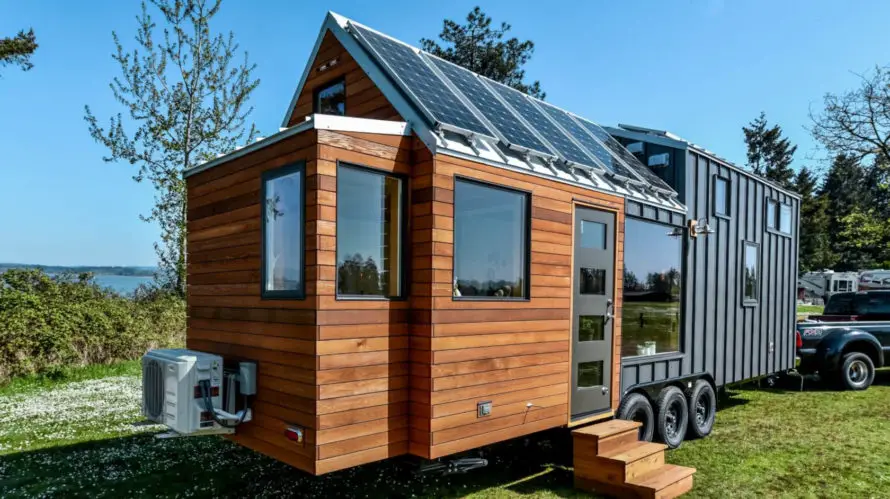There are many tiny house solar panels for sale so you’ll need to do a little homework to determine which brand offers the best solar system. In the following few paragraphs we are going to discuss the factors that you need to take into consideration when choosing the right tiny house solar panel system.

What is Solar Power?
Solar power is a commonly used term for generating power from the sun. For most people, solar power is usually associated with generating electrical power using photovoltaic solar panels that are now quite often seen on the roofs of domestic homes and other buildings.
But in its widest term solar power is really more comprehensive than that. It means collecting electromagnetic radiation from the sun and converting it into useful energy for domestic or industrial use.
And there are a number of ways that solar power can be generated either directly using photovoltaic panels and solar water panels or indirectly by concentrating the energy using lenses or mirrors to generate very high temperatures for steam generation.
Photovoltaic Solar Power
Photovoltaic cells (PV) convert light, not heat, directly into an electric current using the photoelectric effect. The earliest PV cells were selenium based, expensive, and not very efficient.

Today a number of different materials are used but the most common are silicon-based pieces of material that absorb the sun’s light, not warmth, as in thermal application.
An individual solar cell is quite small so cells are grouped together and manufactured into panels with a protective frame and cover. These panels are what we commonly call solar panels that are seen on homes and buildings. And normally there are a number of these solar panels combined and interlinked so that they generate effective quantities of solar power.
Sunlight excites the electrons in the solar cell and generates direct current (DC) solar power electricity which is acceptable for some purposes such as charging batteries. However, is unusable for normal domestic or commercial purposes which rely on alternating current (AC) power.
Consequently, to be of value and for any systems directly connected to the power grid, the DC power must be converted to a useful AC voltage using an inverter. Depending on the geographic location this is normally either 120 volts AC (USA, South America, Japan) or 240 volts AC (UK, Europe, Australasia).
Frequency (electrical cycles per second) also differs at either 50 or 60 Hertz but these issues do not need to be elaborated here.
What to Consider When Buying Tiny House Solar Panels
First off you’ll want to make sure that the solar panels you purchase come with all of the necessary hardware that you’ll need to install them properly.
You’ll need mounting brackets and hardware, including wiring compatible with solar systems. A solar charge controller, battery bank, battery bank connection, and a high-quality waterproof sealant if you’re planning on making this a permanent install.
Keep in mind that you’ll need to be drilling holes into your tiny house and you’ll also be wiring the battery so it can provide power. If you’re not sure how to do either of these things then I suggest calling a professional to have it installed.
Keeping the above information in mind you now have to figure out how much energy you’re going to need. Once you figure out how much energy you use on a given day in your tiny house you can then purchase the correct sized battery bank and solar panels.
How to calculate your daily energy needs?
For example, if you are using about 100 Amp-hours over the course of three days how many watts of solar power would you need to charge this battery bank each day? How many hours of sunlight each day will you require? How quickly can your solar panels recharge the battery bank?

A basic 95-watt solar panel system could recharge a 100 Amp-hour battery bank at a rate of a little over 20 Amp-hours every 4 hours. So if you’re draining that 100 Amp battery bank every 3 days that comes to about 33 Amp-hours a day that you would need to be able to generate.
Using the math from above you can see that a typical 95-watt tiny house solar panel can recharge a 100 Amp battery bank at a rate of about 5 Amps/hour. This means that in order for this particular unit to meet your energy needs you would need to have about 7 hours of daylight. Remember this is for a 95-watt solar panel. Install two 95-watt tiny house solar panels and you will cut that charging time in half, requiring only 3.5 hours of daylight.
Of course, purchasing another solar panel will also double your investment. It’s up to you to do the math and determine how much power you need to replace and how much you’re willing to spend to replace it.
Tiny House Solar Panel Cost
The best tiny house solar panel can be quite pricey as you could pay $1,000–$1,500. But if you’re willing to shop around there are some pretty awesome deals out there. A great place to look for the best solar system at a great price is Amazon.com.
To simplify your shopping I’ve gone ahead and done some homework. Below is a link to some of the best deals on tiny house solar panels. Be sure to check them out and contact the seller to see if these panels come with all of the materials I listed above.
Just think you could be powering your tiny home 100% with solar energy. No more gassing up that noisy generator, just clean, quite renewable energy!







